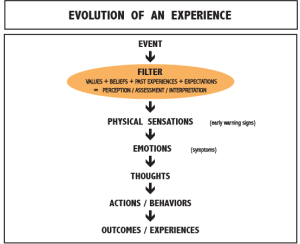Human perception (how we view the world) is dependent on what we experience in our body. The anatomy of any experience follows this sequence — first sensation, then emotion, then thought.
Our personal experiences of sensation-emotion-thought are limited in that they do not include all experiences — only our own. Thus, our limited perception can and does limit our reality in at least two ways:
We cannot see the whole picture. Without a doubt, this is why it is so important to stay centred and focused in the present moment. Life has ingenious ways of signalling us as to what is about to occur. We pick up on these cues or early warning signs through the sensations created in our bodies and with our intuition, both of which enable us to respond in healthy and helpful ways.
Our negative judgments create negative results. If we bypass staying present in the moment, we are more likely to react to Life’s events not from intuition but from our past experience (filter), which again amounts to choosing from a limiting number of scenarios. If the emotions and thoughts associated with the past scenarios are negative (mistrustful, fearful), then the output or results created will emulate the input. This pattern is played out in humanity’s response to global conflict and resistance. For the most part, humanity has chosen to mistrust and fear (negative judgments) those of conflicting beliefs, and thus aggressed against them resulting in war’s negative outcomes.
Another example, seemingly closer to home, exists in how we perceive stress. If over the past 20 years we developed a heightened stress response to the rapid change and complex experiences of our current New Normal environment, likely we habituated our fight-flight instinctual response. By that I mean we now remain on high alert because we treat every experience as if it is life or death. Our body, mind and spirit never get any rest because the fight-flight switch is never turned off. This negative judgment (life is stressful) creates negative outcomes such as chronic fatigue, depression, bipolar disorder, suicide, substance abuse and many other addictions.
As a reminder to us all, most of our negative behavioural responses, like war or stress, developed in our early learning years (before and around the age of 5). Fortunately, children are great observers, but not great interpreters. Infants can and do absorb a great deal of knowledge, however their ability to discern and make good decisions is limited by the immaturity of their perception and development. Not to say that we are unable to learn new patterns at older stages of development, just that the internalizing process is more rapid during the early years and more concretized (resistant to change) in the later years.
So, what do we do when resistance has set in and created habitual response patterns that no longer serve us in healthy and helpful ways? The simple answer — we heal the body.
In a recent yoga intensive, I learned that yoga is the physical development of the soul. When we align our skeleton, muscles, tissue and organs, we create psycho-emotional alignment as well. Put another way, awareness is a physiological development. Our early warning signs in the form of physical sensations alert our awareness to what is present. If we resist these sensations, resistance shows up as us making one or more of the following choices — attachment, avoidance or confusion/ignorance.
With conscious consideration, we can stop and let go of our resistance. We can pause, rest and watch what is emerging, and in this state of acceptance, of just being, we can determine a better course of action.
To transform resistance into acceptance, we must tire of the attachment, aversion or confusion associated with the limiting pattern, and we must approach our resistance. This can be done most effectively through two means — repetition and/or surprise.
Repetition infers that we keep entering into the resistance. Known forms of repetition are physical exercise, mantra recitation, prayer and yoga when done routinely. When we feel our inner fears emerging, allowing ourselves to deeply feel the fear until it shifts or dissipates will keep us entering our resistance rather than relying on our defense mechanisms to distract us. In a similar manner, the element of surprise, as experienced in new situations, allows us to enter our resistance before we can engage our defense mode. This is why new experiences are so important to us.
What fear have you been avoiding in your life? What new experiences can you bring into your life that will heal your body?
To read more on releasing resistance and accepting what is, click here or sign up for Mindful Meditation.






